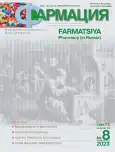Development and standardization of lozenges containing furosemide
- Authors: Zilfikarov I.N.1,2,3, Arutyunov A.K.1, Lebedeva A.S.2, Bochkareva I.I.1, Artemyeva V.V.1
-
Affiliations:
- Maikop State Technological University of the Ministry of Science and Higher Education of the Russian Federation
- ZAO “VIFITEH”, State Scientific Center for Medical and Biology
- All-Russian Scientific Research Institute of Medicinal and Aromatic Plants (VILAR) of the Ministry of Science and Higher Education of the Russian Federation
- Issue: Vol 72, No 8 (2023)
- Pages: 5-12
- Section: Pharmaceutical chemistry and pharmacognosy
- URL: https://journal-vniispk.ru/0367-3014/article/view/249747
- DOI: https://doi.org/10.29296/25419218-2023-08-01
- ID: 249747
Cite item
Abstract
Introduction. Increasing the bioavailability and speed of onset of the diuretic effect of furosemide are necessary for accelerated elimination of toxins in acute and chronic diseases associated with swelling, as well as in acute and chronic poisoning. In conditions where oral or parenteral administration of furosemide is difficult or impossible due to the presence of restrictions in a number of diseases, the use of dosage forms of furosemide with local resorptive action, in particular lozenges, is relevant.
Purpose of the study: Experimental substantiation of quality standards and methods of analysis of lozenges containing furosemide.
Material and methods. The objects of the study are furosemide and lozenges manufactured at the production site of a pharmaceutical company. Research methods: spectrophotometric, chromatographic (HPLC).
Results. The basic physicochemical and technological properties of furosemide have been studied. It has been established that furosemide, as a practically insoluble substance in water, is advisable to introduce into the composition of a drug with local resorptive action in the form of a water-soluble derivative. Methods have been developed for the determination of furosemide in lozenges using two methods, spectrophotometry and HPLC, which meet the main validation criteria, are characterized by accuracy, reproducibility, relative ease of execution, and allow for quality control of the drug at all stages of production.
Conclusion. The physicochemical properties of furosemide make it possible to obtain water-soluble derivatives that can be included in dosage forms with local resorptive action. We have obtained furosemide in the form of a potassium salt, which is the active ingredient of lozenges, the composition of the tablets has been selected and tested, and pilot series have been developed. Methods for the detection and quantitative determination of furosemide have been developed, tested and certified.
Full Text
##article.viewOnOriginalSite##About the authors
Ifrat Nazimovich Zilfikarov
Maikop State Technological University of the Ministry of Science and Higher Education of the Russian Federation; ZAO “VIFITEH”, State Scientific Center for Medical and Biology; All-Russian Scientific Research Institute of Medicinal and Aromatic Plants (VILAR) of the Ministry of Science and Higher Education of the Russian Federation
Author for correspondence.
Email: dagfarm@mail.ru
ORCID iD: 0000-0002-8638-9963
Doctor of Pharmaceutical Sciences, Professor of the Russian Academy of Sciences, Leading Researcher at the Department of Pharmacy of Maikop State Technological University; Deputy General Director of JSC "VIFITECH" for Science; Head of the Laboratory of the Quality Control Department of the All-Russian Research Institute of Medicinal and Aromatic Plants (VILAR)
Russian Federation, st. Pervomaiskaya, 191, Maykop, Republic of Adygea, 385000; room 84, Obolensk village, Serpukhov district, Moscow region, 142279; st. Grina, 7, building 1, Moscow, 117216Artur Karpushovich Arutyunov
Maikop State Technological University of the Ministry of Science and Higher Education of the Russian Federation
Email: ak.arut17@mail.ru
ORCID iD: 0000-0003-3883-6631
Candidate of Medical Sciences, Associate Professor, Dean of the Faculty of Pharmacy, Head of the Department of Pharmacy
Russian Federation, st. Pervomaiskaya, 191, Maykop, Republic of Adygea, 385000Anastasia Sergeevna Lebedeva
ZAO “VIFITEH”, State Scientific Center for Medical and Biology
Email: nastya-kot777@mail.ru
ORCID iD: 0000-0003-0701-1290
Senior Chromatography Engineer of the Laboratory
Russian Federation, room 84, Obolensk village, Serpukhov district, Moscow region, 142279Inna Ivanovna Bochkareva
Maikop State Technological University of the Ministry of Science and Higher Education of the Russian Federation
Email: bochkarevainna@gmail.com
ORCID iD: 0000-0002-7898-4404
Candidate of Pharmaceutical Sciences, Associate Professor of the Department of Pharmacy, Dean of the Faculty of Postgraduate Education
Russian Federation, st. Pervomaiskaya, 191, Maykop, Republic of Adygea, 385000Vera Vladimirovna Artemyeva
Maikop State Technological University of the Ministry of Science and Higher Education of the Russian Federation
Email: kaf_farm@mkgtu.ru
ORCID iD: 0000-0001-8467-2899
Senior Lecturer at the Department of Pharmacy
Russian Federation, st. Pervomaiskaya, 191, Maykop, Republic of Adygea, 385000References
- Beresneva O.N., Penchul N.A. The effect of furosemide on the cardiovascular system in experimental CRF. Nefrologiya. 2000; 4 (2): 97 (in Russian).
- Goryunova T.V., Osmolovskaya Yu.F., Zhirov I.V., Tereshchenko S.N. The choice of loop diuretic in patients with chronic heart failure. RMJ. 2017; 11: 771–4 (in Russian).
- Gosudarstvennaya farmakopeya Rossijskoj Federacii: v 4 t. XIV izd. M., 2018 [E`lektronny`j resurs]. Available at: https://femb.ru/record/pharmacopea14 [Accessed 12 January, 2023] (in Russian).
- Mareev V.Yu., Fomin I.V., Ageev F.T., Begrambekova Yu.L. et al. Russian Heart Failure Society, Russian Society of Cardiology. Russian Scientific Medical Society of Internal Medicine Guidelines for Heart failure: chronic (CHF) and acute decompensated (ADHF). Diagnosis, prevention and treatment. Kardiologiia. 2018; 58 (6S): 8–164. doi: 10.18087/cardio.2475 (in Russian).
- Preobrazhensky D.V., Nekrasova N.I., Khoseva N.I. et al. Torasemide is the Effective Loop Diuretic for Long-Term Therapy of Arterial Hypertension. Kardiologiia. 2011; 4: 67–73 (in Russian).
- Buggey J., Mentz R.J., Pitt B. et al. A reappraisal of loop diuretic choice in heart failure patients. Am. Heart J. 2015; 169: 323–33.
- Felker G.M., Menz R.J. Acute Decompensated Heart Failure. JACC. 2012; 59 (24): 2145–53.
- Hammarlund-Udenaes M., Benet L.Z. Furosemide pharmacokinetics and pharmacodynamics in health and disease – an update. M. J. Pharmacokinet Biopharm. 1989; 17: 1–46.
Supplementary files












